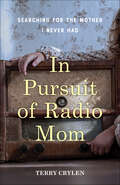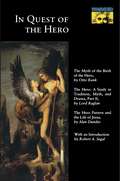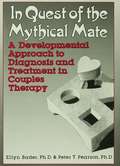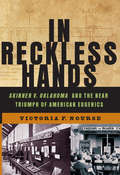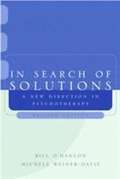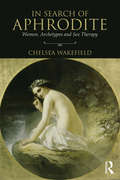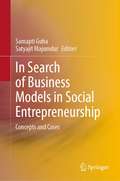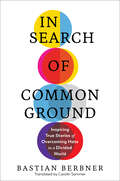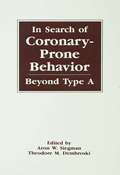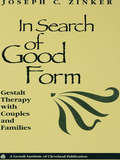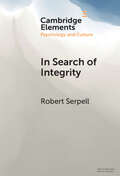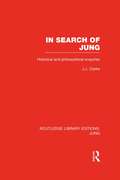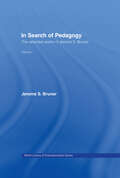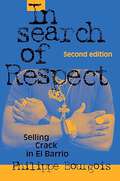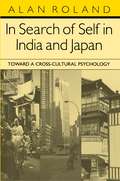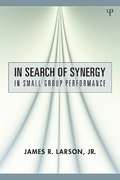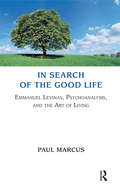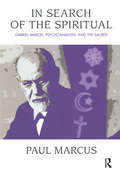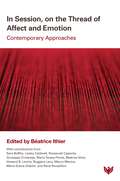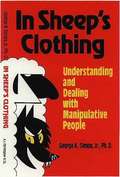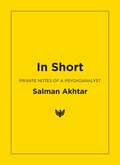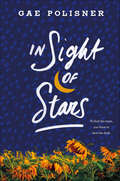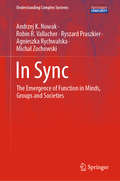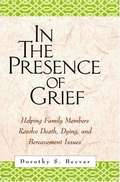- Table View
- List View
In Pursuit of Radio Mom: Searching for the Mother I Never Had
by Terry CrylenIn Pursuit of Radio Mom brings the reader tight to Terry Crylen’s side as it traces her path from frequent and debilitating anxiety, loneliness, and shame—and a dysfunctional marriage that mirrors the dynamics of her relationship with her mother—to the discovery of her authentic self and the happiness and fulfillment such a transformation brings. Radio Mom also illuminates the ways in which one generation impacts the next—both wittingly and unwittingly—when later, while pressing along the difficult route of raising her own daughter, the author is challenged to confront, yet again, the legacy of her past. A book that also makes transparent the process of psychotherapy, In Pursuit of Radio Mom’s message is this: the excavation of pain clears space within the mind and heart—affording the growth of new insight, overturning fear, and making acceptance and forgiveness possible.
In Quest of the Hero: (Mythos Series) (Mythos: The Princeton/Bollingen Series in World Mythology #143)
by Alan Dundes Otto Rank Fitzroy Richard RaglanIn Quest of the Hero makes available for a new generation of readers two key works on hero myths: Otto Rank's Myth of the Birth of the Hero and the central section of Lord Raglan's The Hero. Amplifying these is Alan Dundes's fascinating contemporary inquiry, "The Hero Pattern and the Life of Jesus." Examined here are the patterns found in the lore surrounding historical or legendary figures like Gilgamesh, Moses, David, Oedipus, Odysseus, Perseus, Heracles, Aeneas, Romulus, Siegfried, Lohengrin, Arthur, and Buddha. Rank's monograph remains the classic application of Freudian theory to hero myths. In The Hero the noted English ethnologist Raglan singles out the myth-ritualist pattern in James Frazer's many-sided Golden Bough and applies that pattern to hero myths. Dundes, the eminent folklorist at the University of California at Berkeley, applies the theories of Rank, Raglan, and others to the case of Jesus. In his introduction to this selection from Rank, Raglan, and Dundes, Robert Segal, author of the major study of Joseph Campbell, charts the history of theorizing about hero myths and compares the approaches of Rank, Raglan, Dundes, and Campbell.
In Quest of the Mythical Mate: A Developmental Approach To Diagnosis And Treatment In Couples Therapy
by Ellyn Bader Peter PearsonIn Quest of the Mythical Mate presents a valuable and fertile developmental model for diagnosing and treating couples that is flexible enough to incorporate a wide variety of intervention strategies, yet purposeful enough to give a clear sense of direction to couples in distress. As such, this volume provides a powerful therapeutic approach for all professionals who treat couples.
In Reckless Hands: Skinner v. Oklahoma and the Near-Triumph of American Eugenics
by Victoria F. NourseThe disturbing, forgotten history of America's experiment with eugenics. In the 1920s and 1930s, thousands of men and women were sterilized at asylums and prisons across America. Believing that criminality and mental illness were inherited, state legislatures passed laws calling for the sterilization of "habitual criminals" and the "feebleminded." But in 1936, inmates at Oklahoma's McAlester prison refused to cooperate; a man named Jack Skinner was the first to come to trial. A colorful and heroic cast of characters--from the inmates themselves to their devoted, self-taught lawyer--would fight the case all the way to the U.S. Supreme Court. Only after Americans learned the extent of another large-scale eugenics project--in Nazi Germany--would the inmates triumph. Combining engrossing narrative with sharp legal analysis, Victoria F. Nourse explains the consequences of this landmark decision, still vital today--and reveals the stories of these forgotten men and women who fought for human dignity and the basic right to have a family.
In Search Of Solutions: New Direction In Psychotherapy
by Bill O'Hanlon Michele Weiner-DavisRecognized leaders in the solution-oriented movement, O’Hanlon and Weiner-Davis provide guidelines for clinicians in implementing solution-oriented language and explain how to avoid dead ends. Now available in paperback, including new material to bring the reader up-to-date on advances in this growing field.
In Search of Aphrodite: Women, Archetypes and Sex Therapy
by Chelsea WakefieldWhat does it mean to be “in search of Aphrodite?” For most women, sex is complex, and more than a juxtaposition of body parts. Women sense the possibility of depth, meaning, even transcendence, but in a somatically disconnected, sexually superficial world, it can be difficult for a woman to discover her inner fire, define who she is sexually, and confidently communicate this to her partner.Part philosophy, part treatment manual, In Search of Aphrodite addresses women’s sexual problems from an inspiring, creative perspective, integrating Jungian Psychology and sex therapy. Readers will deepen their understanding of the sexual psyche and how this realm impacts women’s lives, as well as what the author calls the journey of Sexual IndividuationTM. Chelsea Wakefield covers a variety of topics such as healing ancient wounds, resolving inner conflicts, exploring sexual essence, identity, scripts, primal instinct, desire, fantasy, longing, and more. She offers pathways to sexual enrichment and improved communication with a partner. Sexual archetypes are introduced and organized around the author’s Sexual Essence Wheel. Gatekeepers and Eros-inhibiting archetypes are described, along with what to do when treatment stalls. This book is appropriate for:• Clinicians who are nervous about venturing into conversations about women’s sexuality• Clinicians who are comfortable with sexual topics and are curious about new interventions• Sex therapists who want a treatment model that acknowledges the multidimensional aspects of sexuality• Jungian analysts and Jungian oriented practitioners who want helpful tools for addressing sexual issues as an invitation into individuation • Pastoral counselors and spiritual guidance practitioners who seek to heal souls wounded by sexual trauma and sex-negative teachings • Women who want to explore their sexual psyche and define their sexual essence, and men who wish to better understand the sexual depths of women.Rich with case histories and an “Inner Cast of Characters” that clients can explore, this resource will help women discover joyful embodiment, innate eroticism, and sexual pleasure!
In Search of Business Models in Social Entrepreneurship: Concepts and Cases
by Satyajit Majumdar Samapti GuhaThis book discusses different innovative business models adopted by social enterprises to bring about social change in terms of creating capabilities among the marginalised section of people. These models also bring the sustainability of the enterprises to serve the people continuously. Establishing a theoretical base for further research in the area of business models in social entrepreneurship, the book consists of research work from various disciplines from scholars with experience and insights on social entrepreneurship, and who discuss one or more aspect(s) of business model, presenting their work with sound research methodologies. The book takes a broader view of the concept – a) social entrepreneurs are driven by social value and justice, b) social entrepreneur may or may not have a market orientation, c) social entrepreneurs solve variety of social problems such as poverty, health, illiteracy, environmental degradation using the principles of business and with the help of social innovation, and d) social enterprise focus on bringing social change by creating social impact.Chapters of this book are divided into three core themes. The first one – Concepts, Patterns and Values – includes contributions related to sustainable development, business model and vale creation in the context of social entrepreneurship, innovation and cross-cultural influence on business models aspects. The chapter of second theme – Enablers and Influencers – discuss role of corporate in promoting social entrepreneurship as a social responsibility, social entrepreneurship and value creation, BoP market, supply chain, structural and infrastructural choices, family as a stakeholder of indigenous enterprise, and women entrepreneurship. The third and final theme – Innovation – addresses social, open innovation and business model innovations, IPR, firm performance, collaboration and alliance, software and biotechnology industries, decision logic behind social enterprise creation, and strategy and strategic philanthropy concepts. Containing contributions from academia, industry professionals, investors, policy-makers, and other professionals, all from multiple disciplines, the book would interest the same vast audience.
In Search of Common Ground: Inspiring True Stories Of Overcoming Hate In A Divided World
by Bastian BerbnerAn essential book for this moment—here are inspiring stories of people who have built meaningful relationships despite initial deep-seated prejudice, revealing how we can mend our fiercest divides Is there nothing we can do? This is the question that inspired award-winning journalist Bastian Berbner to embark on this book as he surveyed the political arenas in the United States, the United Kingdom, and elsewhere across Europe, compelled by what he describes as “something akin to political fear.” What he found in the course of his reporting are people who, despite significant differences in their worldviews and ideas, were able to trust, listen to, and be open with one another. In Search of Common Ground takes us around the world: to Arizona, where a former neo-Nazi befriends his Black parole officer; to Germany, where an older couple dread the arrival of their new Roma neighbors—but are moved upon meeting them to offer help, becoming their friends and champions; to Ireland, where we see one friendship change the world when a gay-rights activist overturns a conservative mailman’s homophobia—and together, they help sway public opinion to legalize gay marriage. Berbner’s intensively reported and compelling accounts are interwoven with expert insight from Nobel Prize-winning economist Daniel Kahneman, psychologist Peter Coleman of Columbia University, and others. This uplifting book vividly shows that we can overcome prejudice and find common ground.
In Search of Coronary-prone Behavior: Beyond Type A
by Aron W. Siegman Theodore M. DembroskiIn Search of Cornoary-Prone Behavior: Beyond Type A provides a methodology of enormous potential for examining the relationship between behavioral variables and basic pathophysiological mechanisms. They discuss the history of Type-A behavior pattern (TABP) as it relates to coronary heart disease (CHD). Students and researchers with an interest in the correlation between personality and coronary behavior, as well as behavioral medicine, social and health psychology, and the neurosciences.
In Search of Good Form: Gestalt Therapy with Couples and Families
by Joseph C. ZinkerWith In Search of Good Form, Joseph Zinker emphasizes seeing and being with as keys to a phenomenological approach in which therapist and patient co-create and mutually articulate their own experiences and meanings. He considers Gestalt field theory, the Gestalt interactive cycle, and Gestalt concepts.
In Search of Integrity: A Life-Journey across Diverse Contexts (Elements in Psychology and Culture)
by Robert SerpellThis Element traces the origins of an individual's philosophical orientation and the processes by which it was elaborated over the course of his life-journey. The author discusses how selected stories from his personal experience reflect the intimate culture of a particular social group of which he was a participant member at the time. The author's life-journey includes a tumultuous period of emerging adulthood in Singapore and Oxford. Moving to Zambia in 1965 aged 21, he conducted research, teaching and writing including sojourns in England and in Maryland USA. He discusses how his perspective in cultural psychology relates to his personal life as a migrant and as a parent, and to his views on how the world can best address the challenges of cooperative communication in the 2020s.
In Search of Jung: Historical and Philosophical Enquiries (Routledge Library Editions: Jung)
by J. J. ClarkeIs Jung one of the most exciting and important thinkers of our age? Or is he just a dabbler in the occult and oriental mysticism? Although Jung has enjoyed wide popularity over time, he is still not accorded an appropriately honoured place in the history of modern thought. His interest in Oriental thought, alchemy and astrology has alienated many and he is often marginalized by scholars and academics. Originally published in 1992, this book aimed to rectify this state of affairs by showing that Jung was an important thinker in his own right and that his ideas play an important role at the heart of the intellectual debates of our age. The book explores Jung’s relationship with some of the great philosophical thinkers and movements such as Hegel, Nietzsche and existentialism, examines his links with the revolutionary ideas of modern physics and argues that his conception of the human psyche represents an important contribution to perennial questions about mind, human nature and human destiny.
In Search of Memory: The Emergence of a New Science of Mind
by Eric R. Kandel"A stunning book."--Oliver Sacks Memory binds our mental life together. We are who we are in large part because of what we learn and remember. But how does the brain create memories? Nobel Prize winner Eric R. Kandel intertwines the intellectual history of the powerful new science of the mind--a combination of cognitive psychology, neuroscience, and molecular biology--with his own personal quest to understand memory. A deft mixture of memoir and history, modern biology and behavior, In Search of Memory brings readers from Kandel's childhood in Nazi-occupied Vienna to the forefront of one of the great scientific endeavors of the twentieth century: the search for the biological basis of memory.
In Search of Pedagogy Volume I: The Selected Works of Jerome Bruner, 1957-1978
by Jerome S. BrunerJerome Bruner is one of the best-known and most influential psychologists of the twentieth century. His theories about cognitive development dominate psychology around the world today, but it is in the field of education where his influence has been especially felt. In this two volume set, Bruner has selected and assembled his most important writings about education. Volume I spans the twenty years from 1957 to 1978 and Volume II covers 1979 to 2006. Volume I starts with a specially written introduction by Bruner, in which he gives an overview of the 1957-1978 years and contextualises his selection of papers. The articles and chapters then reveal the thinking, the concepts and the empirical research of that time that have made Bruner one of the most respected and cited educational authorities of our time.
In Search of Respect
by Philippe BourgoisPhilippe Bourgois's ethnographic study of social marginalization in inner-city America, won critical acclaim when it was first published in 1995. For the first time, an anthropologist had managed to gain the trust and long-term friendship of street-level drug dealers in one of the roughest ghetto neighborhoods--East Harlem. This new edition adds a prologue describing the major dynamics that have altered life on the streets of East Harlem in the seven years since the first edition. In a new epilogue Bourgois brings up to date the stories of the people--Primo, Caesat, Luis, Tony, Candy--who readers come to know in this remarkable window onto the world of the inner city drug trade. Philippe Bourgois is Professor and Chair of the Department of Anthropology, History and Social Medicine at the University of California, San Francisco. He has conducted fieldwork in Central America on ethnicity and social unrest and is the author of Ethnicity at Work: Divided Labor on a Central American Banana Plantation (Johns Hopkins University Press, 1989). He is writing a book on homeless heroin addicts in San Francisco. 1/e hb ISBN (1996) 0-521-43518-8 1/e pb ISBN (1996) 0-521-57460-9
In Search of Self in India and Japan: Toward a Cross-Cultural Psychology
by Alan RolandDrawing on work with Indian and Japanese patients, a prominent American psychoanalyst explores inner worlds that are markedly different from the Western psyche. A series of fascinating case studies illustrates Alan Roland's argument: the "familial self," rooted in the subtle emotional hierarchical relationships of the family and group, predominates in Indian and Japanese psyches and contrasts strongly with the Western "individualized self." In perceptive and sympathetic terms Roland describes the emotional problems that occur when Indians and Japanese encounter Western culture and the resulting successful integration of new patterns that he calls the "expanding self." Of particular interest are descriptions of the special problems of women in changing society and of the paradoxical relationship of the "spiritual self" of Indians and Japanese to the "familial self.? Also described is Roland's own response to the broadening of his emotional and intellectual horizons as he talked to patients and supervised therapists in India and Japan. "As we were coming in for a landing to Bombay," he writes, "the plane banked so sharply that when I supposedly looked down all I could see were the stars, while if I looked up, there were the lights of the city." This is the "world turned upside down" that he describes so eloquently in this book. What he has learned will fascinate those who wish to deepen their understanding of a different way of being.
In Search of Synergy in Small Group Performance
by James R. Larson, Jr.This volume critically evaluates more than a century of empirical research on the effectiveness of small, task-performing groups, and offers a fresh look at the costs and benefits of collaborative work arrangements. The central question taken up by this book is whether -- and under what conditions -- interaction among group members leads to better performance than would otherwise be achieved simply by combining the separate efforts of an equal number of people who work independently. This question is considered with respect to a range of tasks (idea-generation, problem solving, judgment, and decision-making) and from several different process perspectives (learning and memory, motivation, and member diversity). As a framework for assessing the empirical literature, the book introduces the concept of 'synergy.' Synergy refers to an objective gain in performance that is attributable to group interaction. Further, it distinguishes between weak and strong synergy, which are performance gains of different magnitude. The book highlights the currently available empirical evidence for both weak and strong synergy, identifies the conditions that seem necessary to produce each, and suggests where the search for synergy might best be directed in the future. The book is at once a high-level introduction to the field, a review of the field's history, and a scholarly critique of the current state-of-the-art. As such, it is essential reading for graduate students, advanced undergraduate students, and researchers interested in group dynamics generally -- and small group performance in particular.
In Search of the Good Life: Emmanuel Levinas, Psychoanalysis and the Art of Living
by Paul MarcusEmmanuel Levinas (1906-1995), French phenomenological philosopher and Talmudic commentator, is regarded as perhaps the greatest ethical philosopher of our time. While Levinas enjoys prominence in the philosophical and scholarly community, especially in Europe, there are few if any books or articles written that take Levinas's extremely difficult to understand, if not obtuse, philosophy and apply it to the everyday lives of real people struggling to give greater meaning and purpose, especially ethical meaning, to their personal lives. This book attempts to fill in the large gap in the Levinas literature, mainly through using a Levinasian-inspired, ethically-infused psychoanalytic approach.
In Search of the Spiritual: Gabriel Marcel, Psychoanalysis and the Sacred
by Paul MarcusThis book is a most impressive and important study of the presence of the spiritual and the sacred in the writings of the twentieth century French philosopher Gabriel Marcel, offering immense help in understanding Marcel and in seeing the usefulness of his ideas in psychoanalysis.
In Session, on the Thread of Affect and Emotion: Contemporary Approaches
by Béatrice IthierWith contributions from Sara Boffito, Lesley Caldwell, Roosevelt Cassorla, Giuseppe Civitarese, Maria Teresa Flores, Be'atrice Ithier, Howard B. Levine, Ruggero Levy, Mauro Manica, Maria Grazia Oldoini, and Rene' Roussillon. In Session, on the Thread of Affect and Emotion: Contemporary Approaches is divided into four parts. The first looks at the Freudian and Bionian models and the book begins its journey with an investigation of Freudian metapsychology from Rene' Roussillon. The second part explores the aesthetic dimension of psychoanalysis and the link with truth, with a focus on emotions, dreams, and non-dreams. The third part concerns defensive issues experienced by the analyst and patient in the consulting room and the fourth and final part concerns the intersubjectivity of affect. Mauro Manica and Maria Grazia Oldoini highlight the shift that occurred with Melanie Klein and confirmed by Wilfred Bion in his theory of early links between love, hate, knowledge. It is interesting to see the differing approaches of these contributors from many different countries: France, Italy, Portugal, Brazil, the United States, and the United Kingdom. Whilst their approach to affect and emotion is influenced by their own cultural specificities and creativity, they all emphasise not only the shared affect, but also the emotional presence between the two protagonists. In this way, they give access to the deepest affective sediments, making this a must-read for all practising psychoanalysts and those with an academic interest.
In Sheep's Clothing: Understanding and Dealing with Manipulative People
by George K. Simon"This book clearly illustrates the true nature of disturbed characters, exposes the tactics the most manipulative characters use to pull the wool over the eyes of others, and outlines powerful, practical ways to deal more effectively with manipulative people. "
In Short: Private Notes of a Psychoanalyst
by Salman AkhtarIn Short: Private Notes of a Psychoanalyst is wise, uplifting and inspiring. Salman Akhtar brings his talent for poetic literature to gift us 111 pithy 'proto-essays' on a wide range of subjects. His meditations touch upon mental health, humor, death, animals, Freud, religion, children, and so much more. He imparts his advice with the lightest of touches, willing you to partake, consider, and refine his offerings. His aim: to further the cause and message of his beloved psychoanalysis.
In Sight of Stars: A Novel
by Gae Polisner“An intense, sometimes graphic, totally heartbreaking portrait of a character who will keep pages turning.” - Booklist, Starred Review"An achingly fierce exploration of the way the world wounds us and heals us. If you love exquisitely written coming-of-age stories that will leave you breathless, In Sight of Stars is for you." - Jeff Zentner, William C. Morris award-winning author of The Serpent King and Goodbye DaysSeventeen-year-old Klee’s father was the center of his life. He introduced Klee to the great museums of New York City and the important artists on their walls, he told him stories made of myths and magic. Until his death. Now, forced to live in the suburbs with his mom, Klee can’t help but feel he’s lost all the identifying parts of himself—his beloved father, weekly trips to the MoMA, and the thrumming energy of New York City. That is until he meets wild and free Sarah in art class, with her quick smiles and jokes about his “brooding.” Suddenly it seems as if she’s the only thing that makes him happy. But when an act of betrayal sends him reeling, Klee lands in what is bitingly referred to as the “Ape Can,” a psychiatric hospital for teens in Northhollow. While there, he undergoes intensive therapy and goes back over the pieces of his life to find out what was real, what wasn’t, and whether he can stand on his own feet again. Told in alternating timelines, leading up to the event that gets him committed and working towards getting back out, Gae Polisner’s In Sight of Stars is a gorgeous novel told in minimalist strokes to maximal effect, about what makes us fall apart and how we can put ourselves back together again.
In Sync: The Emergence of Function in Minds, Groups and Societies (Understanding Complex Systems)
by Ryszard Praszkier Robin R. Vallacher Agnieszka Rychwalska Andrzej K. Nowak Michal ZochowskiThis book introduces the reader to the concept of functional synchronization and how it operates on very different levels in psychological and social systems – from the emergence of thought to the formation of social relations and the structure of societies. For years, psychologists have investigated phenomena such as self-concept, social judgment, social relations, group dynamics, and cooperation and conflict, but have discussed these phenomena seoarately.This book shows how synchronization provides a foundational approach to these otherwise distinct and diverse psychological processes.This work shows that there is a basic tendency with many processes to become coordinated and progressively integrated into increasingly larger units through well-defined processes. For these larger units, new and largely adaptive functions emerge. Although synchronization affords progressive integration of system elements to enable correspondingly higher-order functions, the trajectory of synchronization is often characterized by periods of assembly and disassembly of system elements. This occurs when a task is completed and synchronization is no longer essential so that the elements once again operate in an independent fashion. It is argued that the disassembly-resynchronization scenario occurs at all levels of psychological and social reality. The implications of this approach for important issues in interpersonal relations and societal processes are discussed.
In The Presence Of Grief: Helping Family Members Resolve Death, Dying, And Bereavement Issues
by Pauline Boss Dorothy S. Becvar Dorothy Stroh BecvarIlluminating the impact of loss and grief on our psychological and emotional lives, this book provides vital guidance to ease painful transitions and facilitate healing. The author emphasizes that dealing with the death of a loved one involves more than picking up the pieces and moving on: rather, healing is an ongoing journey on which grief is a constant companion. For those in a supportive role, the focus is on helping the bereaved to navigate the grieving process and, ultimately, to reclaim joy as well as sadness as an integral part of life. Filled with personal narratives and examples, the book demonstrates effective ways to help survivors cope with commonly experienced issues, problems, and concerns. Clinical psychologists, family therapists, psychiatrists, social workers, and counselors working with families; physicians and nurses in palliative care settings; hospice professionals. While written for professionals, the book's sensitive coverage of universal themes also makes it suitable for general readers.
